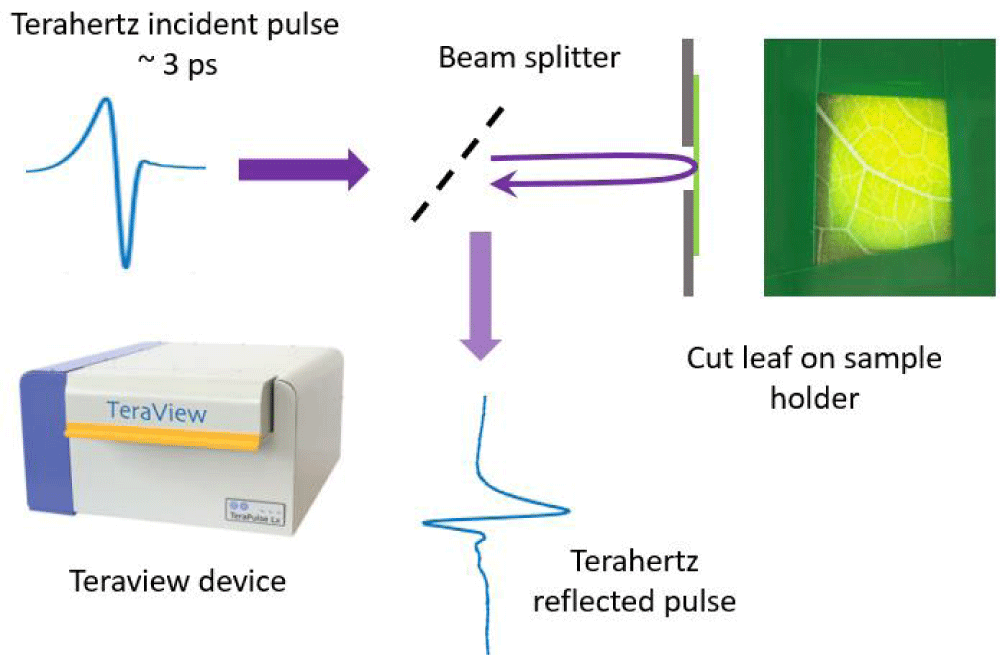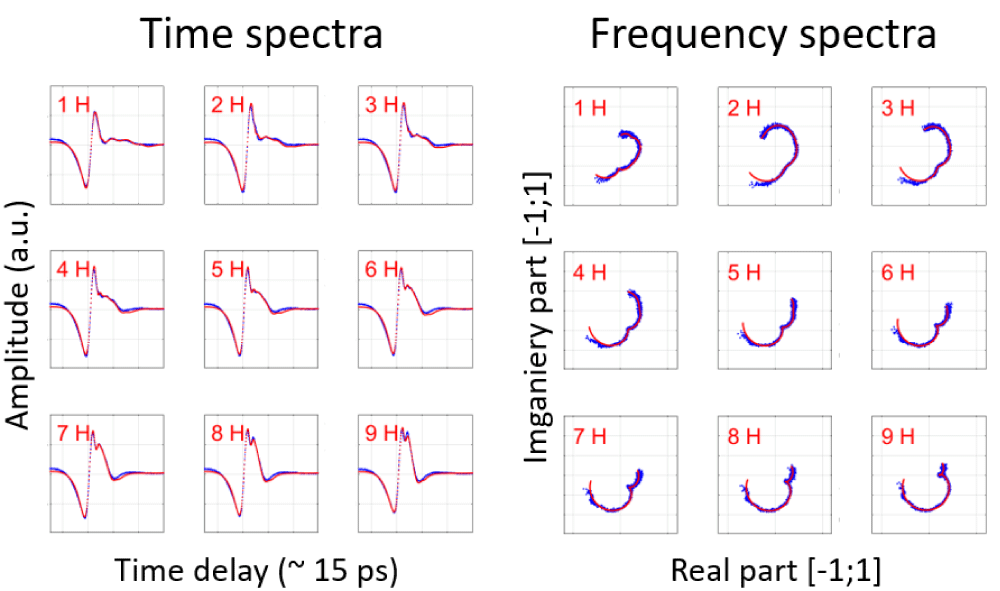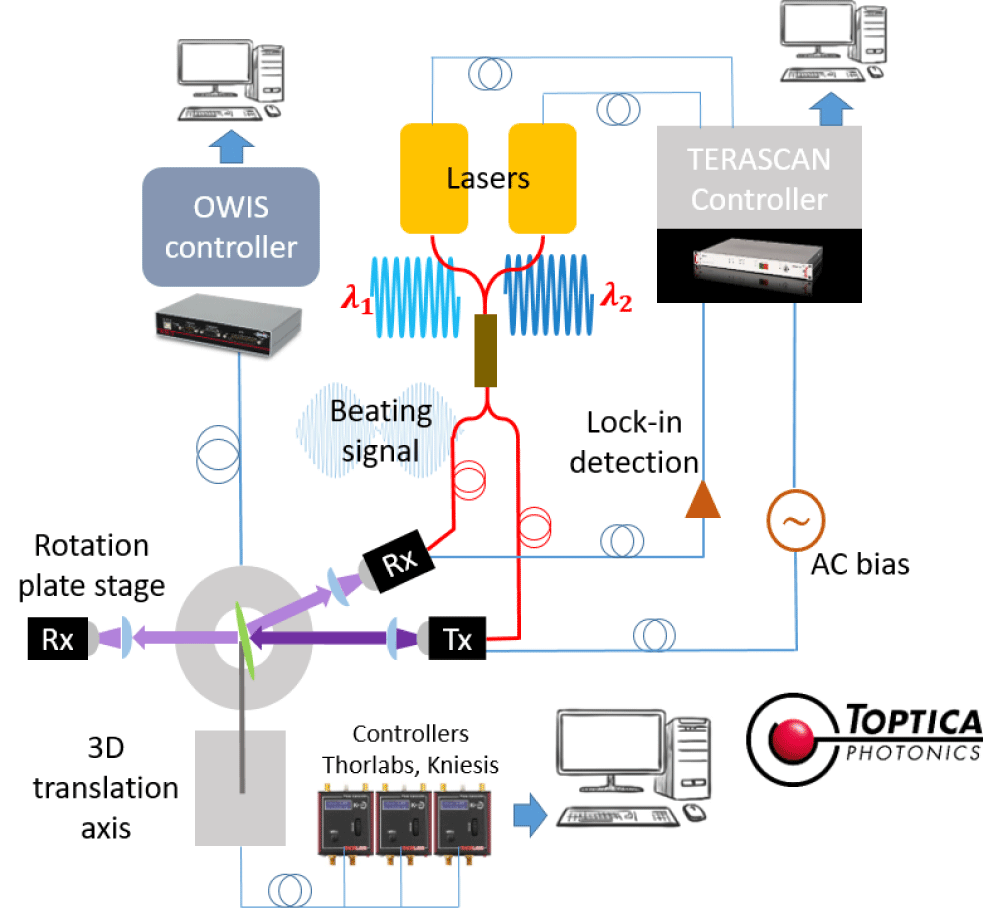More Information
Submitted: April 12, 2023 | Approved: August 31, 2023 | Published: September 01, 2023
How to cite this article: Abautret Y, Coquillat D, Zerrad M, Soriano G, Lequime M, et al. THz Analysis in the Depth of a Sunflower Leaf. J Plant Sci Phytopathol. 2023; 7: 089-091.
DOI: 10.29328/journal.jpsp.1001111
Copyright License: © 2023 Abautret Y, et al. This is an open access article distributed under the Creative Commons Attribution License, which permits unrestricted use, distribution, and reproduction in any medium, provided the original work is properly cited.
THz Analysis in the Depth of a Sunflower Leaf
Yannick Abautret1, Dominique Coquillat2, Myriam Zerrad1, Gabriel Soriano1, Michel Lequime1 and Claude Amra1*
1Aix Marseille Univ, CNRS, Centrale Marseille, Institut Fresnel, Faculté des Sciences - Campus Saint Jérôme, Avenue Escadrille Normandie-Niemen, 13397 Marseille, France
2CNRS, Université Montpellier, Laboratoire Charles Coulomb UMR 5221, 34095 Montpellier, France
*Address for Correspondence: Claude Amra, Aix Marseille Univ, CNRS, Centrale Marseille, Institut Fresnel, Faculté des Sciences - Campus Saint Jérôme, Avenue Escadrille Normandie-Niemen, 13397 Marseille, France, Email: claude.amra@fresnel.fr
The internal structure of a sunflower leaf could be reconstructed by applying RET reverse engineering techniques on measurements from terahertz time-domain probing (Time Domain Spectroscopy TDS). This new and non-destructive method allows us to follow the evolution of this structure in time during a process of dehydration. This paper is a synthesis of our previous work.
Among the many effects of global warming, we can mention the impact on agricultural yields [1-4]. Drought episodes combined with chaotic climatic events call not only for a rethinking of our industrial production methods but also for the refinement of varietal selection techniques. Genetic crosses carried out in the laboratory or sometimes in a natural way allow the creation of species diversity, and in this abundance of individuals and varieties, it is useful to know how to isolate the most profitable and robust offspring with regard to the new conditions and constraints of culture [5,6].
However, it is not always obvious to identify the part of the genetic code of an individual (the genotype) responsible for a behavior or a physical attribute (the phenotype). This observation work of matching genotype and phenotype is called phenotyping [7]. Until now, agricultural phenotyping techniques are essentially based on time and data-consuming statistical analysis. Moreover, these methods of global yield measurements or simple visual integrative observations do not provide sufficient accuracy to match the technologies involved, so new phenotyping techniques become a key element in this context.
This is why a large number of works have been devoted to the non-contact analysis of plants and in particular of plant leaves [8-11]. Among these, optical methods take an important place, and we find for example studies on diffuse reflection or transmission, luminescence, microscopy, coherence tomography (OCT), hyper-spectral imaging, polarization and speckle, and more recently THz [12-14].
However, it should be noted that most of these works give access to a physicochemical characterization of the plant material, insofar as the extracted data are mainly related to the properties of reflection, transmission, and absorption. It is indeed from these optical properties that we seek to identify the chemical concentrations of species present in plant leaves [15,16].
Moreover, imaging techniques, however efficient, are limited to a transverse (or lateral) analysis of the samples, without giving access to a deep characterization. OCT techniques have been developed to overcome this shortcoming, but suffer from the strong scattering caused by the heterogeneities of the components. In the end, there is almost no method to quantitatively and non-destructively analyze the internal geometric structure in the depth of plant leaves, which deprives us of a great wealth of information.
In order to meet this challenge, we have developed a reverse engineering method capable of extracting, from an electromagnetic signal (temporal or spectral), the internal multilayer structure (alternation, indices, and thicknesses) of plant leaves, from cuticles to mesophylls [17]. The first tests in the optical domain were not conclusive, because of a great diffusion responsible for a speckle too complex to be able to find the information related to the structure of the leaf. This is why we chose to operate in the THz domain, because of the long wavelengths (between 100 and 1000 times longer than those of visible optics) which drastically reduce the scattering phenomena. Under these conditions, the plant leaf reflects mostly classical signals (specular reflection and transmission) and thus behaves as a plane multilayer system. This result allows us to implement, in the THz domain and for plant samples, the reverse engineering techniques that we commonly use in the field of optical interference filters [18,19].
The method works globally as follows (Figure 1). A terahertz signal, temporal or spectral, is sent on the sample. The reflected and/or transmitted signal is recovered after interaction with the sample. We then try to approximate this output signal from an electromagnetic calculation performed for a multilayer sheet model (alternation, complex indices, and thicknesses). The multilayer structure is then explored with different optimization algorithms, and the solution closest to the measured signal is retained.
Figure 1: Schematic diagram of the THz measuring instrument in the TDS (Time Domain Spectroscopy) regime - Case of the reflection.
The results obtained on a sunflower leaf were obtained in the framework of a study conducted in 2020 in collaboration with the Charles Coulomb laboratory in Montpellier. The measurement in reflection configuration was performed with the Teraview system operating in the Time Domain Spectroscopy (TDS) regime. This system generates and detects terahertz pulses in a time domain corresponding to a frequency range from 100 GHz to 2 THz. The cut sheet sample was fixed on a pierced disk so as not to introduce any parasitic reflection during the measurement. Finally, to improve the signal-to-noise ratio, we averaged 100 successive measurements for a total acquisition time of 12 minutes.
In order to follow the evolution of the opto-geometric properties of the leaf corresponding to the physiological process of dehydration, we performed a campaign of 50 successive measurements. This represents a total of 50 measurements spaced over 12 mn for a total duration of 10 hours [20]. Each time spectrum is then treated in fourier space to estimate, using a numerical fit, the opto-geometrical structure of the leaf. This structure contains 6 physiologic layers and their refraction index, extinction coefficient, and thickness. The numerical results are given in Figure 2 (the measurement in blue, the calculation in red), and show that the algorithm used allows to follow faithfully the evolution of the terahertz signal, in the time or frequency domain.
Figure 2: Evolution of temporal (left) and frequency (right) spectra during a dehydration process of the sunflower leaf over a total duration of 10 hours [20].
Figure 3 shows the temporal evolution of the thicknesses from the reconstructions based on the thin layer model of the leaf. It can be seen that it is mainly the thicknesses of the two mesophilic layers that decrease significantly (about 50%) during dehydration. As almost all the water of the leaf is contained in these two physiological layers, this observation tends to validate or confirm the model used in this work.
Figure 3: Time evolution of the thicknesses of the physiological layers.
In conclusion, we now have an original and non-contact technique, which allows us to analyze quantitatively and precisely the multilayer structure in the depth of plant leaves. Progress remains to be made, in particular, because we have neglected the spectral dispersion of the complex refractive index. Moreover, joint measurements of reflection and transmission will give access to the absorption spectrum, for a better accuracy of the results. Finally, a difficulty remains related to how to treat the spatial variability of the structure along the plant tissue. A new instrument based on a TERSCAN 1550 source from TOPTICA is under development in our premises and will operate in continuous mode on the same spectral window; it will allow in particular to carry out quasi-simultaneous measurements in reflection and transmission (Figure 4).
Figure 4: Terahertz goniometric measurement bench in continuous regime. Rx reception module can move around the sample and thus allows acquisition in transmission and reflection mode for incident angle running from 0 to 40 degrees. Spectral range used 100 GHz - 1350 GHz.
This work was conducted within the OPTIPAG Project supported by the grant ANR-16-CE04-199 0010 from the French National Research Agency and by the Montpellier University of Excellence 200 I-Site MUSE (PRIME@MUSE), the Région Occitanie, and by the "Gepeto Terahertz platform".
- Chabin JP. Beaune vineyards in the face of global warming. Global Warming. 2007.
- Planton S, Déqué M, Douville H, Spagnoli B. Impact of global warming on the hydrological cycle. Geoscience Reports. 2005; 337: 193-202.
- Seguin B. Global warming and its consequences for viticulture. Global Warming. 2007.
- Masson-Delmotte V, Pörtner HO, Skea J, Zhai P, Roberts D, Shukla PR. Global Warming of 1.5°C: IPCC Special Report on Impacts of Global Warming of 1.5°C above Pre-industrial Levels in Context of Strengthening Response to Climate Change, Sustainable Development, and Efforts to Eradicate Poverty. Cambridge University Press. 2022.
- Buckley TN, Mott KA, Buckley TN, Mott KA. Qualitative effects of patchy stomatal conductance distribution features on gas-exchange calculations. Plant, Cell and Environment. 1997; 20: 867-880.
- Hopkins WG. Plant physiology (De Boeck Supérieur, 2003).
- Roumet P, Baret F, de Solan B, Ecarnot M, Rabatel G, Vigneau N, Vilmus I. Phenotyping in the open field: contributions of techniques based on the spectral properties of the cover. Selector French. 2011; 62: 75–83.
- Shope JC, Peak D, Mott KA. Stomatal responses to humidity in isolated epidermes. Plant Cell Environ. 2008 Sep;31(9):1290-8. doi: 10.1111/j.1365-3040.2008.01844.x. Epub 2008 Jun 6. PMID: 18541007.
- Murchie EH, Lawson T. Chlorophyll fluorescence analysis: a guide to good practice and understanding some new applications. Journal of Experimental Botany. 2013.
- Genty B, Briantais JM, Baker NR. The relationship between the quantum yield of photosynthetic electron transport and quenching of chlorophyll fluorescence. Biochimica et Biophysica Acta (BBA) - General Subjects. 1989.
- Li Y, Li H, Li Y, Zhang S. Improving water-use efficiency by decreasing stomatal conductance and transpiration rate to maintain higher ear photosynthetic rate in drought-resistant wheat. Crop Journal. 2017; 5: 231-239.
- Born N, Behringer D, Liepelt S, Beyer S, Schwerdtfeger M, Ziegenhagen B, Koch M. Monitoring plant drought stress response using terahertz time-domain spectroscopy. Plant Physiol. 2014 Apr;164(4):1571-7. doi: 10.1104/pp.113.233601. Epub 2014 Feb 5. PMID: 24501000; PMCID: PMC3982723.
- Borovkova M, Khodzitsky M, Demchenko P, Cherkasova O, Popov A, Meglinski I. Terahertz time-domain spectroscopy for non-invasive assessment of water content in biological samples. Biomed Opt Express. 2018 Apr 20;9(5):2266-2276. doi: 10.1364/BOE.9.002266. PMID: 29760985; PMCID: PMC5946786.
- Castro-Camus E, Palomar M, Covarrubias AA. Leaf water dynamics of Arabidopsis thaliana monitored in-vivo using terahertz time-domain spectroscopy. Sci Rep. 2013 Oct 9;3:2910. doi: 10.1038/srep02910. PMID: 24105302; PMCID: PMC3793214.
- Féret JB, Gitelson AA, Noble SD, Jacquemoud S. PROSPECT-D: Towards modeling leaf optical properties through a complete lifecycle. Remote Sensing of Environment. 2017; 193: 204-215.
- Jacquemoud S, Baret F. PROSPECT: A model of leaf optical properties spectra. Remote sensing of environment. 1990; 34: 75–91.
- Abautret Y, Coquillat D, Zerrad M, Buet X, Bendoula R, Soriano G, Brouilly N, Héran D, Grèzes-Besset B, Chazallet F, Amra C. Terahertz probing of sunflower leaf multilayer organization. Opt Express. 2020 Nov 9;28(23):35018-35037. doi: 10.1364/OE.400852. PMID: 33182957.
- Amra C, Lequime M, Zerrad M. Electromagnetic Optics of Thin-Film Coatings: Light Scattering, Giant Field Enhancement and Planar Microcavities (Cambridge University Press, 2020).
- Gao L, Lemarchand F, Lequime M. Exploitation of multiple incidences spectrometric measurements for thin film reverse engineering. Opt Express. 2012 Jul 2;20(14):15734-51. doi: 10.1364/OE.20.015734. PMID: 22772265.
- Abautret Y, Coquillat D, Lequime M, Zerrad M, Amra C. Analysis of the multilayer organization of a sunflower leaf during dehydration with terahertz time-domain spectroscopy. Opt Express. 2022 Oct 10;30(21):37971-37979. doi: 10.1364/OE.463228. PMID: 36258389.



